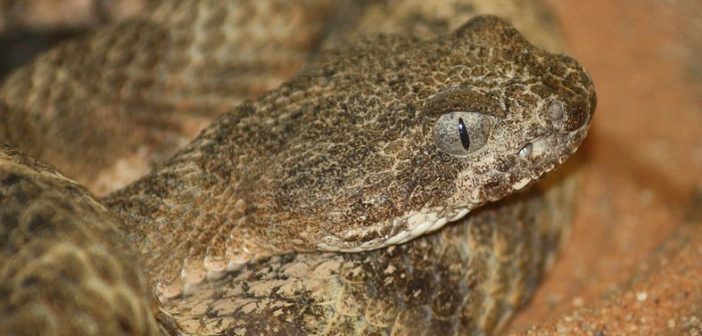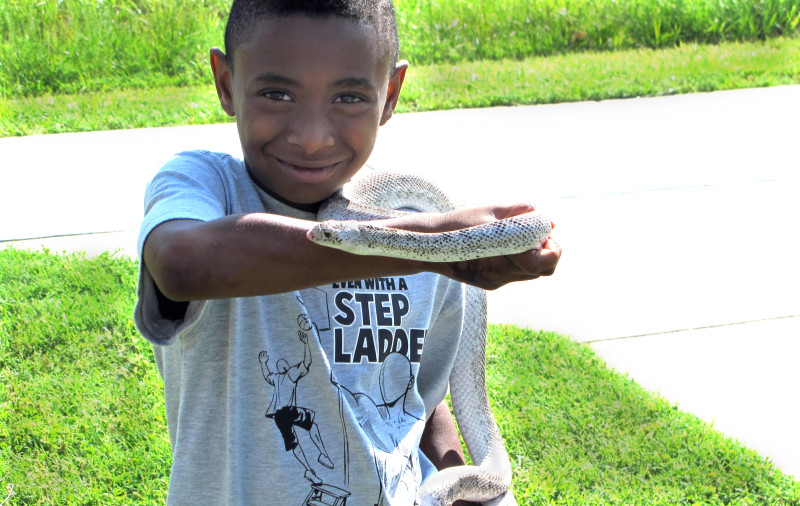Can you identify a snake for me?
Sorry, no. There are about 120 species of snakes in North America, some with subtle markings, and we aren’t confident our identification would be correct. Here’s what to do when you spot one so that you can get help with identification:
- Try to guess the approximate length.
- Note the shape of the head and its size relative to the neck.
- Note the color of the body and any patterning—bands, blotches, etc.
- Are the pupils vertical or round? Round means non-venomous, which most snakes are.
- If you can quickly snap a photo, that will help a lot.
- If you can’t find a match to it online or in a guidebook, show it to your city naturalist or local Wildlife and Parks Department.
Do snakes have a nose?
Snakes have a nose and nostrils they draw air through. It’s their primary method of detecting smells, but not their only one.
Do snakes have eyelids?
No. This missing feature gives them the stare we find so unnerving. Their eyes fit tightly in their head and have limited movement, too. A transparent membrane called the brille protects the eyeball. The pupils of pit vipers, a group of venomous snakes, are vertical and elliptical, which adds to their alien appearance. The pupils of other snakes are round, like a human’s. In the U.S., that’s one way to distinguish a non-venomous from a venomous snake, with one exception: the venomous Coral Snake has round pupils.
How to remove a snake from a house
First, stay calm. The snake is as unhappy as you are. Snakes don’t like confrontation and want to escape. This is true even with venomous ones. Call a professional animal trapper if you need help, especially if you think the snake is venomous.
Don’t kill the snake. It’s an important member of your backyard wildlife habitat. Not only that, but in most states, it’s against the law. Instead, release it close to some protective cover at the back of your yard. Don’t forget to look for the hole it used to enter your house and seal it up.
Don’t lose sight of the snake, or you may never find it again. Snakes can find hundreds of places around your house to hide in, on, behind, or under. Snakes are fast, and you’ll need help. Use brooms to guide it into a box or trash can. Snakes are escape artists, so take care to secure the lid. You can also try to grab the snake by its tail and drag it outside. Or hold it by the tail, lift the front of his body with a stick, and carry it out. Another technique is throwing a towel or blanket over the snake and quickly scooping the whole bundle into a container.
University of Missouri Extension offers these other suggestions: Use a long stick with a Y-shaped end to pin the snake to the floor while sweeping it into a large bucket. Or, place damp, rumpled cloths where the snake has been seen. The snake will be attracted, so once it enters the pile, gather everything up and carry it outside. Or, use a glue board, available at local hardware stores. Once caught, carry the board and snake outdoors, and soak the board with vegetable oil, which will loosen the glue. Observe to make sure the snake doesn’t get preyed on before it can defend itself. In a short time, it’ll be able to free itself and slither away.
Snakeskin found in house
If the skin is dry, the snake may be gone. Skin is usually about 25% larger than the snake that sheds it. Take the skin to your state’s Department of Fish and Wildlife or the city naturalist for identification. If you find several dry skins, it doesn’t necessarily mean several snakes are in your house. It may be one snake that has molted several times. If you determine the skin to be that of a venomous snake, contact a professional animal trapper for help. If the snake is harmless, you’ll need to start hunting for it, and a good place to start is where you found the snakeskin. Read the Q&A just above for snake removal tips.
How to identify a venomous snake
Non-venomous snakes in the U.S. have round pupils, with the sole exception of the Coral Snake. Venomous snakes have vertical, or elliptical, cat-like pupils. The photo at the top of this page is that of a venomous snake. Most venomous snakes are called “pit vipers.” They have a noticeable “pit” on each side of their face near their nostrils. It’s best not to get close enough to discern these characteristics! Also, most venomous snakes have a triangular-shaped head.
First-aid for a non-venomous snake bite
Unless you’re certain the bite is from a non-venomous snake, seek immediate medical attention. For a non-venomous bite, wash the area with soap and water and rinse. Allow the bite to bleed for several minutes. Apply an antibiotic ointment. Watch for developing signs of infection—swelling, redness, warmth, tenderness, red streaks—and, in that event, seek medical attention.
First-aid for a venomous snake bite
According to the American Red Cross, this is what you should do for a venomous snake bite:
- Don’t put ice on the wound; it can be harmful.
- Don’t use a tourniquet; it can cause the loss of the entire limb.
- Don’t open the wound; it can cause more harm than good.
- Wash the bite with soap and water.
- Immobilize the affected area.
- Call 911 or go immediately to an emergency room.
- Keep the bitten area lower than the heart.
- If the victim can’t get to medical care within 30 minutes, wrap a bandage 2-4 inches (5.1-10.2 cm)
above the bite to slow down the venom. Don’t wrap it tightly enough to cut off blood flow
(you should be able to slip a finger under it.) - Try placing a suction cup over the bite to help draw venom out of the wound.





